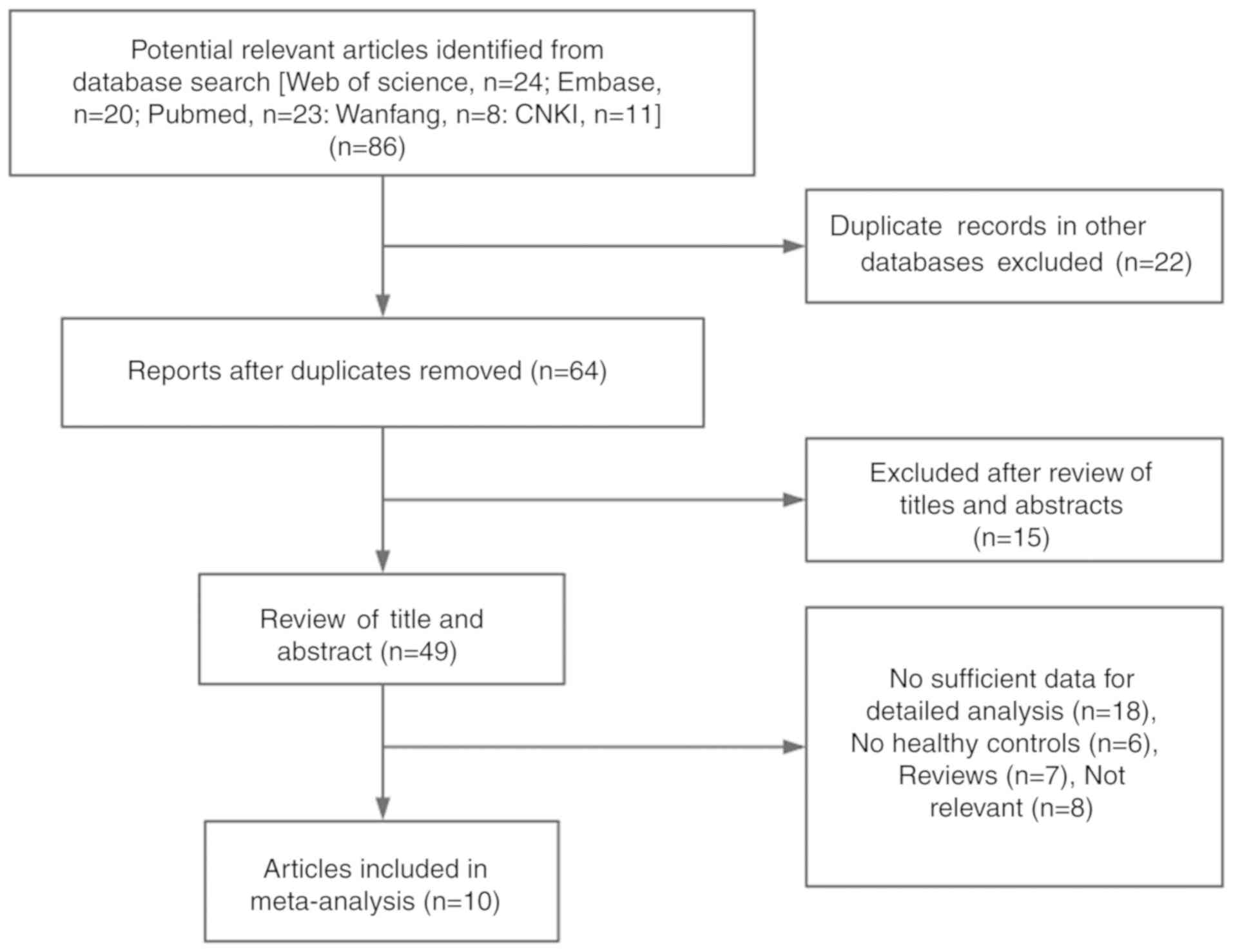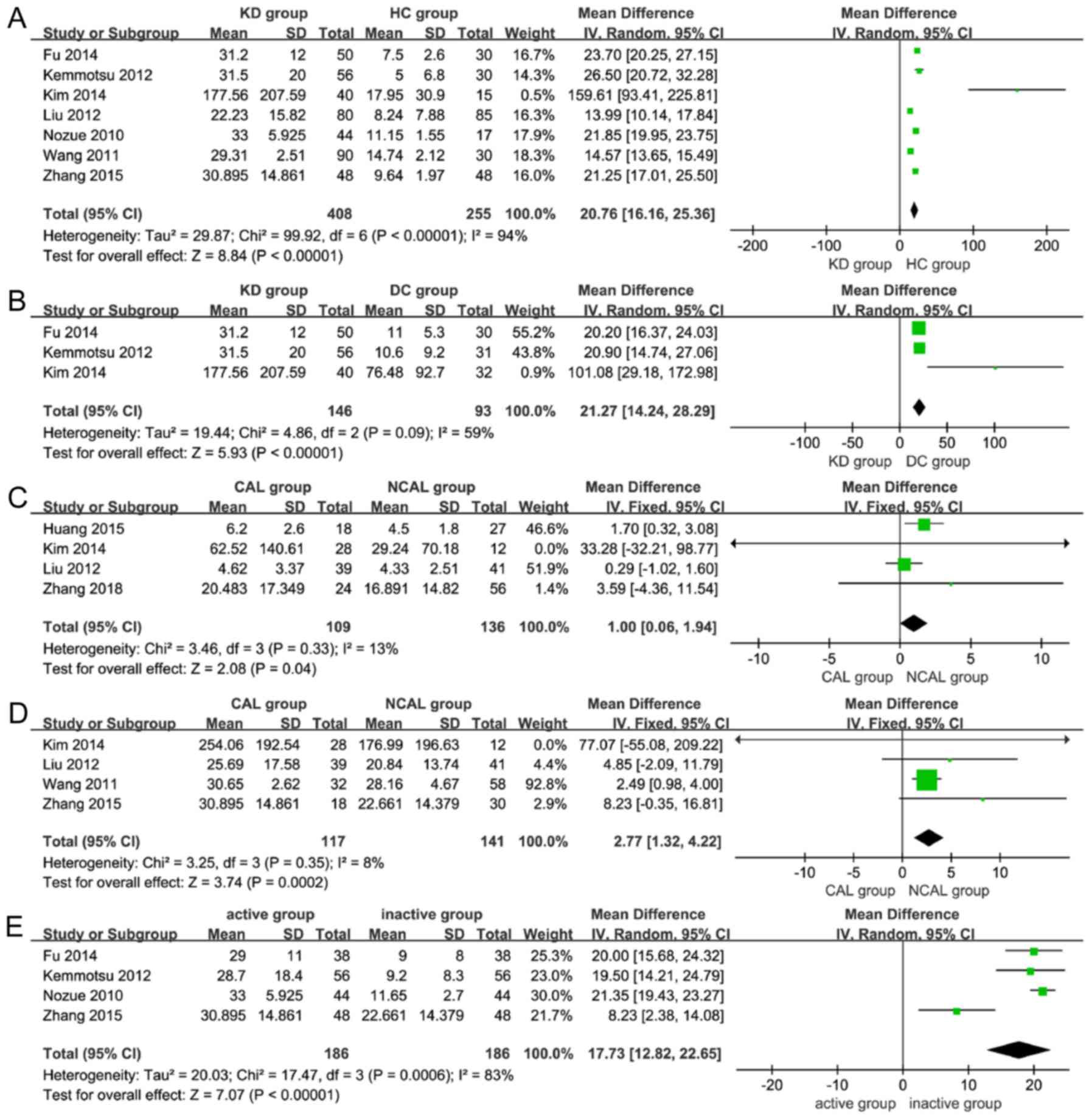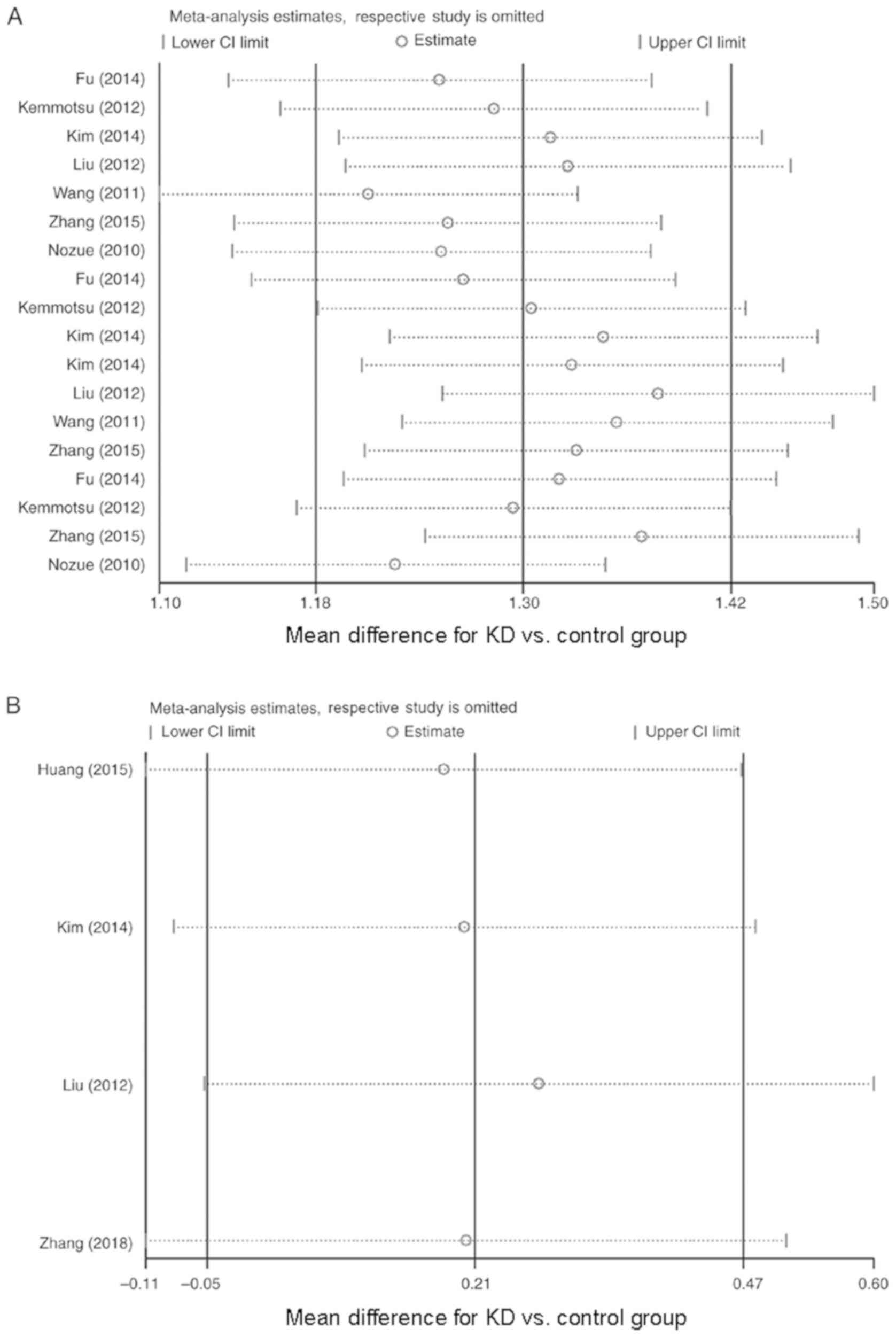|
1
|
Dietz SM, Tacke CE, Hutten BA and Kuijpers
TW: Peripheral endothelial (Dys)function, arterial stiffness and
carotid intima-media thickness in patients after kawasaki disease:
A systematic review and meta-analyses. PLoS One. 10:e01309132015.
View Article : Google Scholar : PubMed/NCBI
|
|
2
|
Chen KY, Curtis N, Dahdah N, Kowalski R,
Cheung M and Burgner DP: Kawasaki disease and cardiovascular risk:
A comprehensive review of subclinical vascular changes in the
longer term. Acta Paediatr. 105:752–761. 2016. View Article : Google Scholar : PubMed/NCBI
|
|
3
|
Zhu FH and Ang JY: The clinical diagnosis
and management of kawasaki disease: A review and update. Curr
Infect Dis Rep. 18:322016. View Article : Google Scholar : PubMed/NCBI
|
|
4
|
Chung HS and Choi KM: Adipokines and
myokines: A pivotal role in metabolic and cardiovascular disorders.
Curr Med Chem. 25:2401–2415. 2018. View Article : Google Scholar : PubMed/NCBI
|
|
5
|
Hutcheson J: Adipokines influence the
inflammatory balance in autoimmunity. Cytokine. 75:272–279. 2015.
View Article : Google Scholar : PubMed/NCBI
|
|
6
|
Jamaluddin MS, Weakley SM, Yao Q and Chen
C: Resistin: Functional roles and therapeutic considerations for
cardiovascular disease. Br J Pharmacol. 165:622–632. 2012.
View Article : Google Scholar : PubMed/NCBI
|
|
7
|
Degawa-Yamauchi M, Bovenkerk JE, Juliar
BE, Watson W, Kerr K, Jones R, Zhu Q and Considine RV: Serum
resistin (FIZZ3) protein is increased in obese humans. J Clin
Endocrinol Metab. 88:5452–5455. 2003. View Article : Google Scholar : PubMed/NCBI
|
|
8
|
Bokarewa M, Nagaev I, Dahlberg L, Smith U
and Tarkowski A: Resistin, an adipokine with potent proinflammatory
properties. J Immunol. 174:5789–5795. 2005. View Article : Google Scholar : PubMed/NCBI
|
|
9
|
Tarkowski A, Bjersing J, Shestakov A and
Bokarewa MI: Resistin competes with lipopolysaccharide for binding
to toll-like receptor 4. J Cell Mol Med. 14:1419–1431. 2010.
View Article : Google Scholar : PubMed/NCBI
|
|
10
|
Sun Y, Xun K, Wang C, Zhao H, Bi H, Chen X
and Wang Y: Adiponectin, an unlocking adipocytokine. Cardiovasc
Ther. 27:59–75. 2009. View Article : Google Scholar : PubMed/NCBI
|
|
11
|
Scotece M, Conde J, López V, Lago F, Pino
J, Gómez-Reino JJ and Gualillo O: Adiponectin and leptin: New
targets in inflammation. Basic Clin Pharmacol Toxicol. 114:97–102.
2014. View Article : Google Scholar : PubMed/NCBI
|
|
12
|
Francisco V, Ruiz-Fernández C, Pino J,
Mera A, González-Gay MA, Gómez R, Lago F, Mobasheri A and Gualillo
O: Adipokines: Linking metabolic syndrome, the immune system, and
arthritic diseases. Biochem Pharmacol. 165:196–206. 2019.
View Article : Google Scholar : PubMed/NCBI
|
|
13
|
Frommer KW, Zimmermann B, Meier FM,
Schröder D, Heil M, Schäffler A, Büchler C, Steinmeyer J, Brentano
F, Gay S, et al: Adiponectin-mediated changes in effector cells
involved in the pathophysiology of rheumatoid arthritis. Arthritis
Rheumatol. 62:2886–2899. 2010. View Article : Google Scholar
|
|
14
|
Versini M, Jeandel PY, Rosenthal E and
Shoenfeld Y: Obesity in autoimmune diseases: Not a passive
bystander. Autoimmun Rev. 13:981–1000. 2014. View Article : Google Scholar : PubMed/NCBI
|
|
15
|
Stofkova A: Leptin and adiponectin: From
energy and metabolic dysbalance to inflammation and autoimmunity.
Endocr Regul. 43:157–168. 2009.PubMed/NCBI
|
|
16
|
Takeshita S, Takabayashi H and Yoshida N:
Circulating adiponectin levels in Kawasaki disease. Acta Paediatr.
95:1312–1314. 2006. View Article : Google Scholar : PubMed/NCBI
|
|
17
|
Zhang XY, Yang TT, Hu XF, Wen Y, Fang F
and Lu HL: Circulating adipokines are associated with Kawasaki
disease. Pediatr Rheumatol Online J. 16:332018. View Article : Google Scholar : PubMed/NCBI
|
|
18
|
Kemmotsu Y, Saji T, Kusunoki N, Tanaka N,
Nishimura C, Ishiguro A and Kawai S: Serum adipokine profiles in
Kawasaki disease. Mod Rheumatol. 22:66–72. 2012. View Article : Google Scholar : PubMed/NCBI
|
|
19
|
Fu SF, Yu DL, Lu DY and Chen FY: Changes
in serum levels of resistin and visfatin in pediatric patients with
acute Kawasaki disease following intravenous immune globulin
treatment. Zhongguo Dang Dai Er Ke Za Zhi. 16:44–47. 2014.(In
Chinese). PubMed/NCBI
|
|
20
|
Liu R, He B, Gao F, Liu Q and Yi Q:
Relationship between adipokines and coronary artery aneurysm in
children with Kawasaki disease. Transl Res. 160:131–136. 2012.
View Article : Google Scholar : PubMed/NCBI
|
|
21
|
Kim HJ, Choi EH and Kil HR: Association
between adipokines and coronary artery lesions in Children with
Kawasaki Disease. J Korean Med Sci. 29:1385–1390. 2014. View Article : Google Scholar : PubMed/NCBI
|
|
22
|
Huang M, Dong QH, Jiang HY, Zhang JY and
Shi XJ: Serum adiponectin levels in children with Kawasaki disease.
Zhongguo Dang Dai Er Ke Za Zhi. 17:35–39. 2015.(In Chinese).
PubMed/NCBI
|
|
23
|
Nozue H, Imai H, Saitoh H, Aoki T,
Ichikawa K and Kamoda T: Serum resistin concentrations in children
with Kawasaki disease. Inflamm Res. 59:915–920. 2010. View Article : Google Scholar : PubMed/NCBI
|
|
24
|
Zhang LR, Qiu WG, Pan XF and Liu RY:
Changes of serum resistin hemoglobin level in children with
kawasaki disease and its relationship with the degree of coronary
artery dilation. Shandong Yi Yao Za Zhi. 55:89–91. 2015.(In
Chinese).
|
|
25
|
Wang XY, Huang YM and Zhang WL: Changes of
contents of endothelin and resistin in children with kawasaki
disease. Zhonghua Lin Chuang Yi Shi Za Zhi (Dian Zi Ban).
05:170–171. 2011.(In Chinese).
|
|
26
|
JCS Joint Working Group, : Guidelines for
diagnosis and management of cardiovascular sequelae in Kawasaki
disease (JCS 2013). Digest version. Circ J. 78:2521–2562. 2014.
View Article : Google Scholar : PubMed/NCBI
|
|
27
|
Sosa T, Brower L and Divanovic A:
Diagnosis and management of Kawasaki disease. JAMA Pediatr.
173:278–279. 2019. View Article : Google Scholar : PubMed/NCBI
|
|
28
|
Jiang S, Song K, Feng S and Shi YB:
Association between serum leptin levels and peritoneal dialysis: A
meta-analysis. Exp Ther Med. 10:3002015. View Article : Google Scholar : PubMed/NCBI
|
|
29
|
Li D, Qian W, Li RR, Zhang J, Li KE and Wu
Y: Correlation between lung neoplasm and serum level of
osteopontin: A meta-analysis. Biomed Rep. 4:567–572. 2016.
View Article : Google Scholar : PubMed/NCBI
|
|
30
|
Ridout KK, Ridout SJ, Price LH, Sen S and
Tyrka AR: Depression and telomere length: A meta-analysis. J Affect
Disord. 191:237–247. 2016. View Article : Google Scholar : PubMed/NCBI
|
|
31
|
Hozo SP, Djulbegovic B and Hozo I:
Estimating the mean and variance from the median, range, and the
size of a sample. BMC Med Res Methodol. 5:132005. View Article : Google Scholar : PubMed/NCBI
|
|
32
|
Stang A: Critical evaluation of the
Newcastle-Ottawa scale for the assessment of the quality of
nonrandomized studies in meta-analyses. Eur J Epidemiol.
25:603–605. 2010. View Article : Google Scholar : PubMed/NCBI
|
|
33
|
Zhu B, Zhu Q, Li N, Wu T and Liu S and Liu
S: Association of serum/plasma high mobility group box 1 with
autoimmune diseases: A systematic review and meta-analysis.
Medicine (Baltimore). 97:e115312018. View Article : Google Scholar : PubMed/NCBI
|
|
34
|
Lee YH and Song GG: Urinary MCP-1 as a
biomarker for lupus nephritis: A meta-analysis. Z Rheumatol.
76:357–363. 2017. View Article : Google Scholar : PubMed/NCBI
|
|
35
|
Song F and Gilbody S: Bias in
meta-analysis detected by a simple, graphical test. Increase in
studies of publication bias coincided with increasing use of
meta-analysis. BMJ. 316:4711998.PubMed/NCBI
|
|
36
|
Greenberg AS and Obin MS: Obesity and the
role of adipose tissue in inflammation and metabolism. Am J Clin
Nutr. 83 (Suppl):S461–S465. 2006. View Article : Google Scholar
|
|
37
|
Kajimura S: Adipose tissue in 2016:
Advances in the understanding of adipose tissue biology. Nat Rev
Endocrinol. 13:69–70. 2017. View Article : Google Scholar : PubMed/NCBI
|
|
38
|
Gremese E, Tolusso B, Gigante MR and
Ferraccioli G: Obesity as a risk and severity factor in rheumatic
diseases (autoimmune chronic inflammatory diseases). Front Immunol.
5:5762014. View Article : Google Scholar : PubMed/NCBI
|
|
39
|
Huang Q, Tao SS, Zhang YJ, Zhang C, Li LJ,
Zhao W, Zhao MQ, Li P, Pan HF, Mao C and Ye DQ: Serum resistin
levels in patients with rheumatoid arthritis and systemic lupus
erythematosus: A meta-analysis. Clin Rheumatol. 34:1713–1720. 2015.
View Article : Google Scholar : PubMed/NCBI
|
|
40
|
Li HM, Zhang TP, Leng RX, Li XP, Li XM,
Liu HR, Ye DQ and Pan HF: Emerging role of adipokines in systemic
lupus erythematosus. Immunol Res. 64:820–830. 2016. View Article : Google Scholar : PubMed/NCBI
|
|
41
|
Sawicka K and Krasowska D: Adipokines in
connective tissue diseases. Clin Exp Rheumatol. 34:1101–1112.
2016.PubMed/NCBI
|
|
42
|
Guerrero-García JDJ, Carrera-Quintanar L,
López-Roa RI, Márquez-Aguirre AL and Ortuño-Sahagún D: Multiple
sclerosis and obesity: Possible roles of adipokines. Mediators
Inflamm. 2016:40362322016. View Article : Google Scholar : PubMed/NCBI
|
|
43
|
Guzik TJ, Skiba DS, Touyz RM and Harrison
DG: The role of infiltrating immune cells in dysfunctional adipose
tissue. Cardiovasc Res. 113:1009–1023. 2017. View Article : Google Scholar : PubMed/NCBI
|
|
44
|
Sato H, Muraoka S, Kusunoki N, Masuoka S,
Yamada S, Ogasawara H, Imai T, Akasaka Y, Tochigi N, Takahashi H,
et al: Resistin upregulates chemokine production by fibroblast-like
synoviocytes from patients with rheumatoid arthritis. Arthritis Res
Ther. 19:2632017. View Article : Google Scholar : PubMed/NCBI
|
|
45
|
Senolt L, Housa D, Vernerová Z, Jirásek T,
Svobodová R, Veigl D, Anderlová K, Müller-Ladner U, Pavelka K and
Haluzík M: Resistin in rheumatoid arthritis synovial tissue,
synovial fluid and serum. Ann Rheum Dis. 66:4582007. View Article : Google Scholar : PubMed/NCBI
|
|
46
|
Hutcheson J, Ye Y, Han J, Arriens C,
Saxena R, Li QZ, Mohan C and Wu T: Resistin as a potential marker
of renal disease in lupus nephritis. Clin Exp Immunol. 179:435–443.
2015. View Article : Google Scholar : PubMed/NCBI
|
|
47
|
Syrbe U, Callhoff J, Conrad K, Poddubnyy
D, Haibel H, Junker S, Frommer KW, Müller-Ladner U, Neumann E and
Sieper J: Serum adipokine levels in patients with ankylosing
spondylitis and their relationship to clinical parameters and
radiographic spinal progression. Arthritis Rheumatol. 67:678–685.
2015. View Article : Google Scholar : PubMed/NCBI
|
|
48
|
Karmiris K and Koutroubakis IE: Resistin:
Another rising biomarker in inflammatory bowel disease. Eur J
Gastroenterol Hepatol. 19:1035–1037. 2007. View Article : Google Scholar : PubMed/NCBI
|
|
49
|
Konrad A, Lehrke M, Schachinger V, Seibold
F, Stark R, Ochsenkühn T, Parhofer KG, Göke B and Broedl UC:
Resistin is an inflammatory marker of inflammatory bowel disease in
humans. Eur J Gastroenterol Hepatol. 19:1070–1074. 2007. View Article : Google Scholar : PubMed/NCBI
|
|
50
|
Boström EA, D'Elia HF, Dahlgren U,
Simark-Mattsson C, Hasséus B, Carlsten H, Tarkowski A and Bokarewa
M: Salivary resistin reflects local inflammation in Sjögren's
syndrome. J Rheumatol. 35:2005–2011. 2008.PubMed/NCBI
|
|
51
|
Huang H, Shen E, Tang S, Tan X, Guo X,
Wang Q and Ding H: Increased serum resistin levels correlate with
psoriasis: A meta-analysis. Lipids Health Dis. 14:442015.
View Article : Google Scholar : PubMed/NCBI
|
|
52
|
Peng YJ, Shen TL, Chen YS, Mersmann HJ,
Liu BH and Ding ST: Adiponectin and adiponectin receptor 1
overexpression enhance inflammatory bowel disease. J Biomed Sci.
25:242018. View Article : Google Scholar : PubMed/NCBI
|
|
53
|
Luo Y and Liu M: Adiponectin: A versatile
player of innate immunity. J Mol Cell Biol. 8:120–128. 2016.
View Article : Google Scholar : PubMed/NCBI
|
|
54
|
Okamoto Y, Kihara S, Funahashi T,
Matsuzawa Y and Libby P: Adiponectin: A key adipocytokine in
metabolic syndrome. Clin Sci (Lond). 110:267–278. 2006. View Article : Google Scholar : PubMed/NCBI
|
|
55
|
Krysiak R, Handzlik-Orlik G and Okopien B:
The role of adipokines in connective tissue diseases. Eur J Nutr.
51:513–528. 2012. View Article : Google Scholar : PubMed/NCBI
|
|
56
|
Fantuzzi G: Adiponectin and inflammation:
Consensus and controversy. J Allergy Clin Immunol. 121:326–330.
2008. View Article : Google Scholar : PubMed/NCBI
|
|
57
|
Nagaraju GP, Rajitha B, Aliya S,
Kotipatruni RP, Madanraj AS, Hammond A, Park D, Chigurupati S, Alam
A and Pattnaik S: The role of adiponectin in obesity-associated
female-specific carcinogenesis. Cytokine Growth Factor Rev.
31:37–48. 2016. View Article : Google Scholar : PubMed/NCBI
|
|
58
|
Scotece M, Conde J, Gómez R, López V, Lago
F, Gómez-Reino JJ and Gualillo O: Beyond fat mass: Exploring the
role of adipokines in rheumatic diseases. ScientificWorldJournal.
11:1932–1947. 2011. View Article : Google Scholar : PubMed/NCBI
|
|
59
|
Beltowski J: Leptin and atherosclerosis.
Atherosclerosis. 189:47–60. 2006. View Article : Google Scholar : PubMed/NCBI
|
|
60
|
Dini AA, Wang P and Ye DQ: Serum
adiponectin levels in patients with systemic lupus erythematosus: A
meta-analysis. J Clin Rheumatol. 23:361–367. 2017. View Article : Google Scholar : PubMed/NCBI
|
|
61
|
Liu D, Luo S and Li Z: Multifaceted roles
of adiponectin in rheumatoid arthritis. Int Immunopharmacol.
28:1084–1090. 2015. View Article : Google Scholar : PubMed/NCBI
|
|
62
|
Wu XW, Ji HZ and Wang FY: Meta-analysis of
ciprofloxacin in treatment of Crohn's disease. Biomed Rep. 3:70–74.
2015. View Article : Google Scholar : PubMed/NCBI
|
|
63
|
Zhao F, Wang Y, Liu L and Bian M:
Erythropoietin for cancer-associated malignant anemia: A
meta-analysis. Mol Clin Oncol. 6:925–930. 2017. View Article : Google Scholar : PubMed/NCBI
|
|
64
|
Yin M, Li G, Song H and Lin S: Identifying
the association between interleukin-6 and lichen planus: A
meta-analysis. Biomed Rep. 6:571–575. 2017. View Article : Google Scholar : PubMed/NCBI
|
|
65
|
Li Y, Zeng X, He J, Gui Y, Zhao S, Chen H,
Sun Q, Jia N and Yuan H: Circular RNA as a biomarker for cancer: A
systematic meta-analysis. Oncol Lett. 16:4078–4084. 2018.PubMed/NCBI
|

















